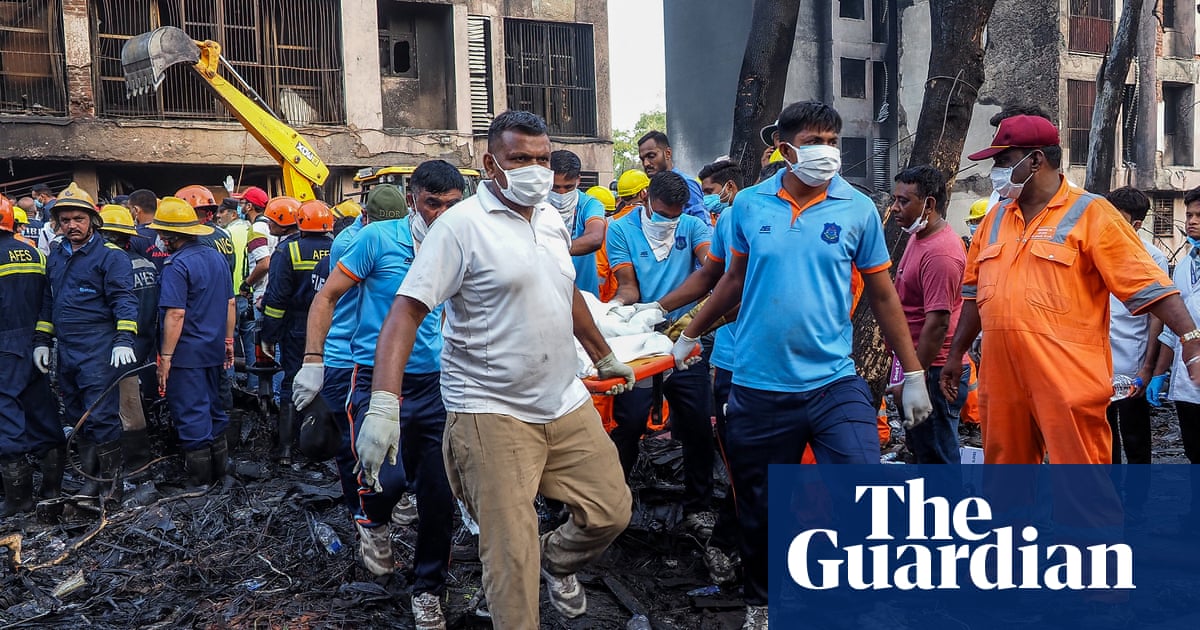Rescue teams with sniffer dogs were combing the crash site of aLondon-bound passenger jetthat ploughed into a residential area of India’s Ahmedabad city, killing at least 265 people on board and on the ground.
One man aboard the Air India Boeing 787-8 Dreamliner – carrying 242 passengers and crew –miraculously survivedThursday’s crash, which left the tailpiece of the aircraft jutting out of the second floor of a hostel for medical staff from a nearby hospital.
The nose and front wheel landed on a canteen building where students were having lunch, witnesses said.
Deputy Commissioner of Police Kanan Desai said that 265 bodies had so far been counted – including people who died on the ground – but the toll may rise as more body parts are recovered.
Ambulances containing empty wooden coffins for the bodies have been arriving at the hospital.
“The official number of deceased will be declared only after DNA testing is completed,” home minister Amit Shah said in a statement late on Thursday, adding that “families whose relatives are abroad have already been informed, and their DNA samples will be taken.”
The 242 people onboard included two pilots and 10 cabin crew. The passengers included 217 adults, 11 children and two infants, according to Reuters. Of the passengers, 169 were Indian nationals, 53 were Britons, seven Portuguese, and one Canadian, AirIndiasaid.
One of two black boxes has been found after an Air India plane crashed in Ahmedabad, local newspaper Hindustan Times reported on Friday.
Prime Minister Narendra Modi, who on Friday visited the devastated neighbourhood where Air India flight 171 went down, earlier described the crash as “heartbreaking beyond words”.
Air India said the sole survivor from the plane – a British national of Indian origin who local media named as Vishwash Kumar Ramesh – was being treated in hospital.
Footage filmed shortly after the crash showed Ramesh bloodied and limping as he walked to an ambulance. Police said he had been sitting in an emergency exit row and had managed to jump out.
“He said, ’I have no idea how I exited the plane’”, his brother Nayan Kumar Ramesh, 27, told Press Association in Leicester.
In Ahmedabad, relatives of passengers gathered on Friday at an emergency centre to give DNA samples so their loved ones could be identified.
Ashfaque Nanabawa, 40, said he had come to find his cousin Akeel Nanabawa, who had been aboard with his wife and three-year-old daughter. They had spoken as his cousin sat in the plane, just before takeoff. “He called us and he said: ‘I am in the plane and I have boarded safely and everything was OK’. That was his last call.”
The plane crashed less than a minute after takeoff, around lunchtime on Thursday, after lifting barely 100 metres from the ground. It issued a mayday call and “crashed immediately after takeoff”, the Directorate General of Civil Aviation said.
Ahmedabad, the main city in India’s Gujarat state, is home to around 8 million people and its busy airport is surrounded by densely packed residential areas.
“One half of the plane crashed into the residential building where doctors lived with their families,” said Krishna, a doctor who did not give his full name.
Boeing said it was in touch with Air India and stood “ready to support them” over the incident which, according to the Aviation Safety Network database, was the first crash for a Boeing 787. The UK and US air accident investigation agencies announced they were sending teams to support their Indian counterparts.
Tata Group, the parent company of Air India, said it would provide 10m rupees (£86,000) to the families of those killed in the crash. The company said it would also cover the medical costs of those injured and provide support in the “building up” of the medical college hit by the plane.
India has suffered a series of fatal air crashes, including a 1996 disaster when two jets collided mid-air over New Delhi, killing nearly 350 people. In 2010, an Air India Express jet crashed and burst into flames at Mangalore airport in south-west India, killing 158 of the 166 passengers and crew on board.
Experts said it was too early to speculate on what may have caused Thursday’s crash.
“It is very unlikely that the plane was overweight or carrying too much fuel,” said Jason Knight, senior lecturer in fluid mechanics at the University of Portsmouth.
“The aircraft is designed to be able to fly on one engine, so the most likely cause of the crash is a double engine failure. The most likely cause of a double engine failure is a bird strike.”
The UK Foreign Office said officials were working with Indian authorities to establish the facts around the crash and provide support to those involved. Gatwick airport officials said a reception centre was being set up for relatives of the passengers.
